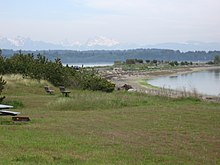96:
104:
112:
123:. The spit seemed like a logical place to set up a post as a launching point for further exploration into the mainland. A trading post was soon established at the spit, and the owner drew up plans for Semiahmoo City. Semiahmoo was expected to become a migration boomtown, but it eventually developed into a fishing town, as the spit provided shelter for Drayton Harbor and an abundance of coastal resources. Whatcom County's first salmon cannery opened in 1881 in Semiahmoo; in 1891, the Alaska Packers Association was the largest salmon cannery in the world.
28:
83:
headland. Smaller, less dense sediment, such as gravel, sand, mud, and clay, can be carried and deposited farther away from the headland because they do not require as much energy for transport. One mile to the north of the tip of the spit is the border between the United States and Canada. Approximately four miles to the northeast of the tip of the spit is the city of
78:, therefore, tends to be northeasterly. Because waves are mainly powered by wind, the waves approaching Semiahmoo hit the shore obliquely, at an angle of approximately 30 to 45 degrees to the northeast, and thus the prevailing wind through the Strait of Georgia must also be northeasterly. Because of longshore drift, sediments are picked up from the
82:
and deposited according to size and based on wave energy. High energy wave action can carry large sediment, such as cobbles and gravel, but only as long as the energy exists. Since the waves repeatedly hit the shore, energy is lost, and so larger, denser sediments are quickly deposited near the
127:
canning was to be the main source of revenue in
Semiahmoo until 1980, when the land was purchased by the land development corporation. Recently, a park with a small, seasonal interpretive center was built near the headland, and the
140:
Because of its location, the spit provides access to countless resources that thrive in both the calm waters of
Drayton Harbor, and the ocean currents through the
174:
226:
47:
148:
is clearly visible in many places, on either side of the spit, as wave action has cut away at the shore, revealing historic artifacts.
231:
144:. Historically, the Lummi Indian Nation used the spit for its natural resources; a major village was built on the spit. Today,
17:
87:. The spit is approximately 1.25 miles (2.01 km) long and contains approximately 125 acres (0.51 km) of land.
95:
111:
187:
103:
84:
135:
55:
181:", 10 photos, 3 color transparencies, 2 data pages, 2 photo caption pages
8:
74:, a constructive geomorphologic process, is northeasterly. Longshore drift through the
162:
51:
157:
141:
75:
136:
Use of the spit by the Lummi Indian Nation, and current archaeological investigation
42:
that protrudes from the westernmost expanse of shore on
Semiahmoo Peninsula between
179:
Semiahmoo
Cannery, On Boundary Bay near Canadian border, Blaine, Whatcom County, WA
129:
59:
71:
39:
220:
202:
189:
43:
145:
120:
178:
79:
119:
In 1858, prospectors came to the
Semiahmoo area searching for the
70:
It is oriented toward the northeast, which means the direction of
124:
27:
115:
Semiahmoo cannery workers at a filling machine, August 1918
163:
http://www.nathpo.org/News/NAGPRA/News-NAGPRA49.html
158:http://www.ghosttowns.com/states/wa/semiahmoo.html
218:
65:
132:and Golf Course was built near the spit.
110:
102:
94:
26:
227:Landforms of Whatcom County, Washington
14:
219:
62:. The spit is home to Semiahmoo Park.
99:Semiahmoo cannery office, August 1918
175:Historic American Engineering Record
107:"Native quarters", Semiahmoo cannery
24:
25:
243:
168:
232:Headlands of Washington (state)
13:
1:
151:
85:White Rock, British Columbia
7:
66:Geomorphology and geography
10:
248:
90:
177:(HAER) No. WA-11, "
116:
108:
100:
32:
114:
106:
98:
30:
18:Semiahmoo, Washington
199: /
203:48.983°N 122.783°W
117:
109:
101:
33:
142:Strait of Georgia
76:Strait of Georgia
50:off the coast of
16:(Redirected from
239:
214:
213:
211:
210:
209:
208:48.983; -122.783
204:
200:
197:
196:
195:
192:
130:Semiahmoo Resort
60:Washington state
21:
247:
246:
242:
241:
240:
238:
237:
236:
217:
216:
207:
205:
201:
198:
193:
190:
188:
186:
185:
171:
154:
138:
93:
72:longshore drift
68:
23:
22:
15:
12:
11:
5:
245:
235:
234:
229:
183:
182:
170:
169:External links
167:
166:
165:
160:
153:
150:
137:
134:
92:
89:
67:
64:
56:Whatcom County
48:Drayton Harbor
36:Semiahmoo Spit
31:Semiahmoo Spit
9:
6:
4:
3:
2:
244:
233:
230:
228:
225:
224:
222:
215:
212:
180:
176:
173:
172:
164:
161:
159:
156:
155:
149:
147:
143:
133:
131:
126:
122:
113:
105:
97:
88:
86:
81:
77:
73:
63:
61:
57:
53:
49:
45:
44:Semiahmoo Bay
41:
37:
29:
19:
184:
146:shell midden
139:
121:Fraser River
118:
69:
35:
34:
206: /
221:Categories
152:References
194:122°47′W
80:headland
191:48°59′N
91:History
125:Salmon
52:Blaine
38:is a
46:and
40:spit
54:in
223::
58:,
20:)
Text is available under the Creative Commons Attribution-ShareAlike License. Additional terms may apply.



